Report: Assessment of Different Chronic Diseases and Patient Care
VerifiedAdded on 2020/03/28
|14
|2678
|67
Report
AI Summary
This report presents a comprehensive assessment of various chronic diseases, encompassing patient case studies across respiratory, gastrointestinal, CPR, neurological, and cardiac rehabilitation contexts. The assessment includes detailed findings, prescribed treatments, medication rationales, and nursing care models. The report analyzes patient vital signs, diagnostic procedures like chest physiotherapy and X-rays, and the application of team nursing models. It also covers specific conditions such as paralytic ileus and the rationale behind interventions like CPR and neurological observations. Furthermore, the report provides comparisons of ECG results and the effects of prescribed medications, offering a holistic view of chronic disease management and patient care strategies.
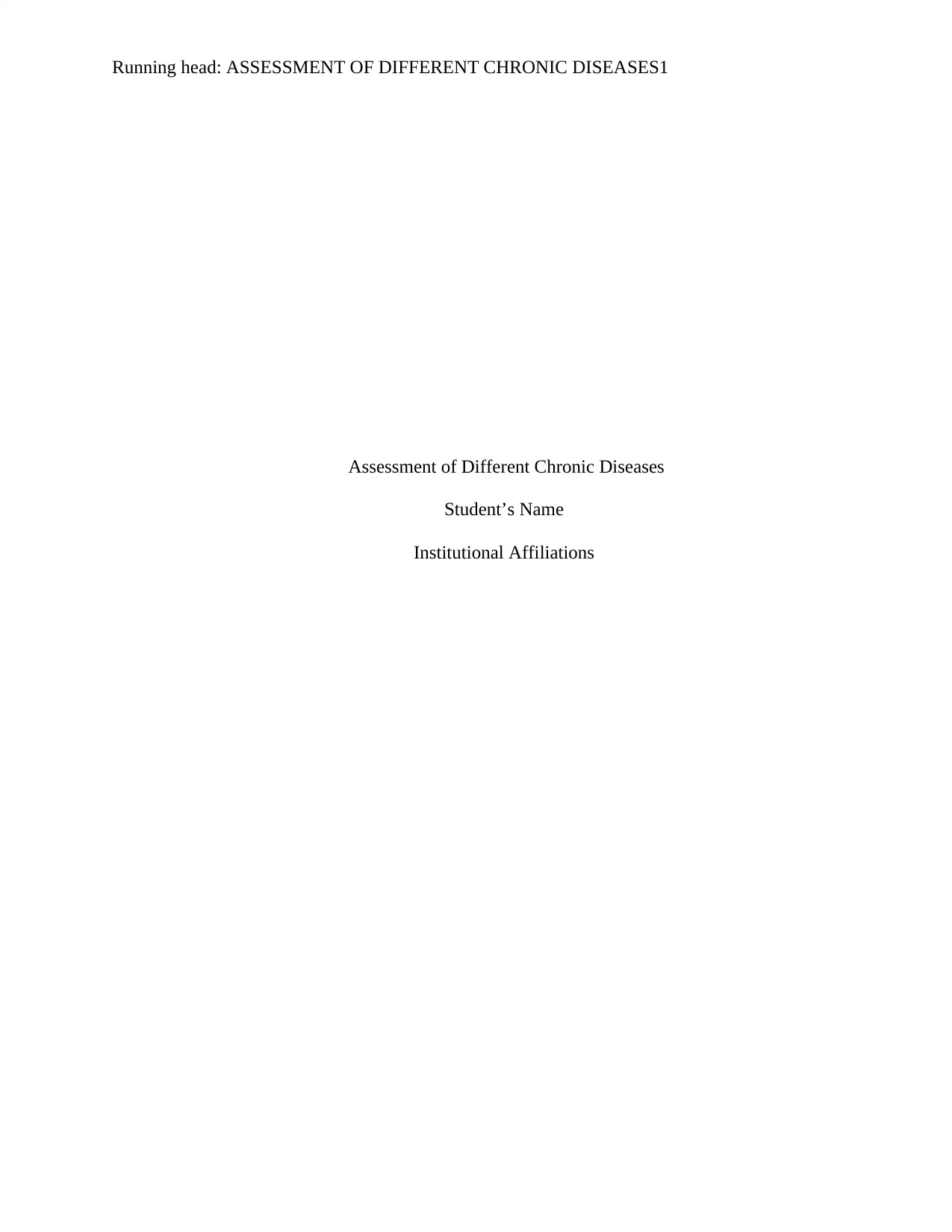
Running head: ASSESSMENT OF DIFFERENT CHRONIC DISEASES1
Assessment of Different Chronic Diseases
Student’s Name
Institutional Affiliations
Assessment of Different Chronic Diseases
Student’s Name
Institutional Affiliations
Paraphrase This Document
Need a fresh take? Get an instant paraphrase of this document with our AI Paraphraser
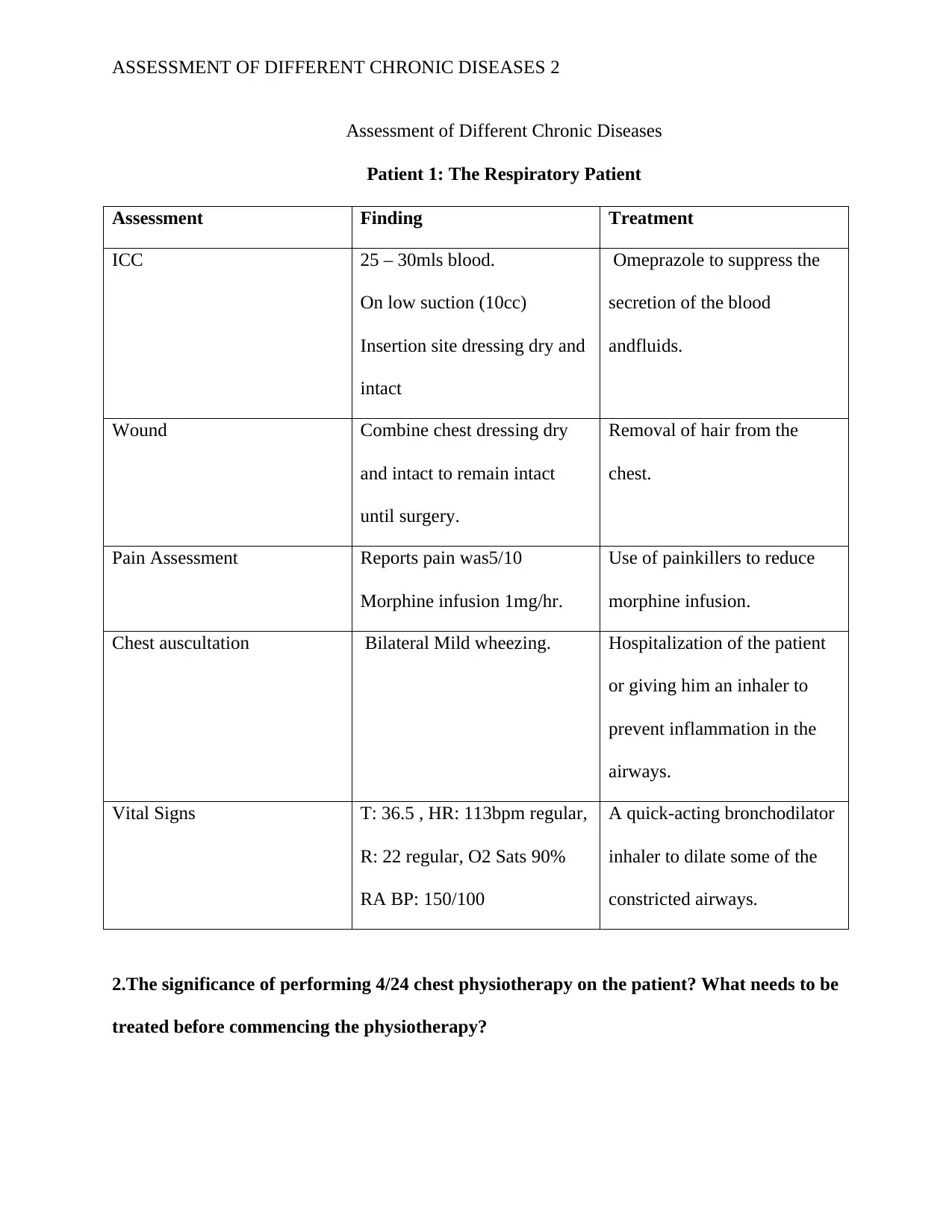
ASSESSMENT OF DIFFERENT CHRONIC DISEASES 2
Assessment of Different Chronic Diseases
Patient 1: The Respiratory Patient
Assessment Finding Treatment
ICC 25 – 30mls blood.
On low suction (10cc)
Insertion site dressing dry and
intact
Omeprazole to suppress the
secretion of the blood
andfluids.
Wound Combine chest dressing dry
and intact to remain intact
until surgery.
Removal of hair from the
chest.
Pain Assessment Reports pain was5/10
Morphine infusion 1mg/hr.
Use of painkillers to reduce
morphine infusion.
Chest auscultation Bilateral Mild wheezing. Hospitalization of the patient
or giving him an inhaler to
prevent inflammation in the
airways.
Vital Signs T: 36.5 , HR: 113bpm regular,
R: 22 regular, O2 Sats 90%
RA BP: 150/100
A quick-acting bronchodilator
inhaler to dilate some of the
constricted airways.
2.The significance of performing 4/24 chest physiotherapy on the patient? What needs to be
treated before commencing the physiotherapy?
Assessment of Different Chronic Diseases
Patient 1: The Respiratory Patient
Assessment Finding Treatment
ICC 25 – 30mls blood.
On low suction (10cc)
Insertion site dressing dry and
intact
Omeprazole to suppress the
secretion of the blood
andfluids.
Wound Combine chest dressing dry
and intact to remain intact
until surgery.
Removal of hair from the
chest.
Pain Assessment Reports pain was5/10
Morphine infusion 1mg/hr.
Use of painkillers to reduce
morphine infusion.
Chest auscultation Bilateral Mild wheezing. Hospitalization of the patient
or giving him an inhaler to
prevent inflammation in the
airways.
Vital Signs T: 36.5 , HR: 113bpm regular,
R: 22 regular, O2 Sats 90%
RA BP: 150/100
A quick-acting bronchodilator
inhaler to dilate some of the
constricted airways.
2.The significance of performing 4/24 chest physiotherapy on the patient? What needs to be
treated before commencing the physiotherapy?

ASSESSMENT OF DIFFERENT CHRONIC DISEASES 3
The 4/24 chest physiotherapy will aid in preventing impairments, improving the overall
patient’s fitness and reducing the length of hospital stay. Most importantly, the physiotherapy
will be able to clear the secretions as well as enhance the mobility of the chest wall of the patient
through encouraging him to cough or breathing exercise (Hovi et al. 2015). Before the medical
practitioner commences the physiotherapy, he or she should conduct an MRI or X-ray to aid in
determining if anything is going on, which can prevent the patient’s body from positively
responding to the physiotherapy.
3. The rationale for Mr. Abdul-Matin being ordered the medications below.
Medication Rationale
Salbutamol The drug will relieve chest tightness, coughing, wheezing as well as short-
term dilation of bronchodilation(airways)
Amoxicillin Help in treating some of the bacterial sinusitis as well as other respiratory
infections.
Ipratropium It will prevent and control shortness of breath and wheezing. It will relax
the muscles round the airways in order for them to open up and allow the
patient breath easily. The drug will also prevent symptoms of lung
diseases.
Hydrocortisone The drug will decline the patient’s immune system responses to diseases
and reduce symptoms such as severe pain. It will also treat breathing
problems the patient has.
Oxycodone It will help in relieving moderate to any severe pain. It will work in the
brain to change how the patient’s body feels as well as responds to pain.
Heparin S/C Heparin injection will prevent the blood clots formation in the veins,
The 4/24 chest physiotherapy will aid in preventing impairments, improving the overall
patient’s fitness and reducing the length of hospital stay. Most importantly, the physiotherapy
will be able to clear the secretions as well as enhance the mobility of the chest wall of the patient
through encouraging him to cough or breathing exercise (Hovi et al. 2015). Before the medical
practitioner commences the physiotherapy, he or she should conduct an MRI or X-ray to aid in
determining if anything is going on, which can prevent the patient’s body from positively
responding to the physiotherapy.
3. The rationale for Mr. Abdul-Matin being ordered the medications below.
Medication Rationale
Salbutamol The drug will relieve chest tightness, coughing, wheezing as well as short-
term dilation of bronchodilation(airways)
Amoxicillin Help in treating some of the bacterial sinusitis as well as other respiratory
infections.
Ipratropium It will prevent and control shortness of breath and wheezing. It will relax
the muscles round the airways in order for them to open up and allow the
patient breath easily. The drug will also prevent symptoms of lung
diseases.
Hydrocortisone The drug will decline the patient’s immune system responses to diseases
and reduce symptoms such as severe pain. It will also treat breathing
problems the patient has.
Oxycodone It will help in relieving moderate to any severe pain. It will work in the
brain to change how the patient’s body feels as well as responds to pain.
Heparin S/C Heparin injection will prevent the blood clots formation in the veins,
⊘ This is a preview!⊘
Do you want full access?
Subscribe today to unlock all pages.

Trusted by 1+ million students worldwide
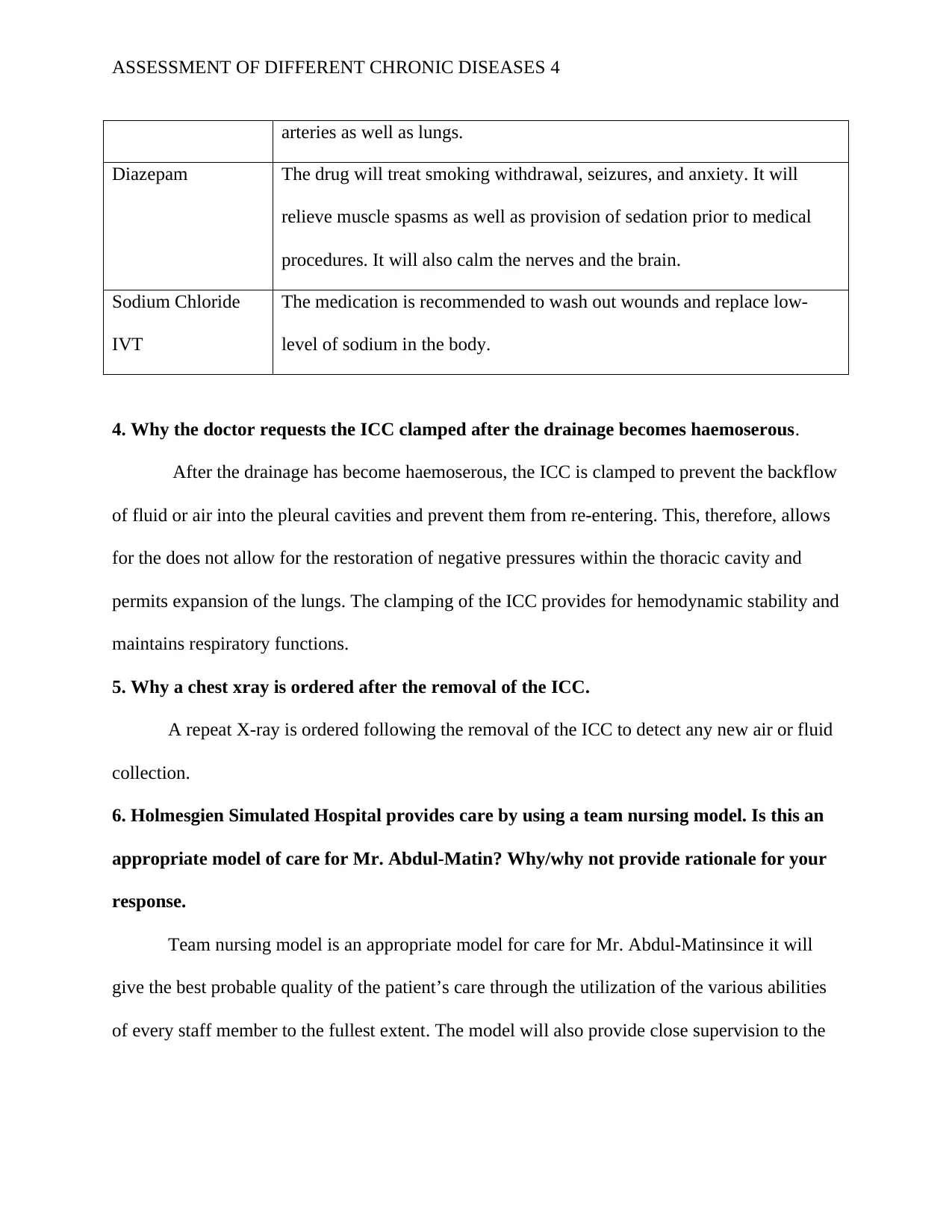
ASSESSMENT OF DIFFERENT CHRONIC DISEASES 4
arteries as well as lungs.
Diazepam The drug will treat smoking withdrawal, seizures, and anxiety. It will
relieve muscle spasms as well as provision of sedation prior to medical
procedures. It will also calm the nerves and the brain.
Sodium Chloride
IVT
The medication is recommended to wash out wounds and replace low-
level of sodium in the body.
4. Why the doctor requests the ICC clamped after the drainage becomes haemoserous.
After the drainage has become haemoserous, the ICC is clamped to prevent the backflow
of fluid or air into the pleural cavities and prevent them from re-entering. This, therefore, allows
for the does not allow for the restoration of negative pressures within the thoracic cavity and
permits expansion of the lungs. The clamping of the ICC provides for hemodynamic stability and
maintains respiratory functions.
5. Why a chest xray is ordered after the removal of the ICC.
A repeat X-ray is ordered following the removal of the ICC to detect any new air or fluid
collection.
6. Holmesgien Simulated Hospital provides care by using a team nursing model. Is this an
appropriate model of care for Mr. Abdul-Matin? Why/why not provide rationale for your
response.
Team nursing model is an appropriate model for care for Mr. Abdul-Matinsince it will
give the best probable quality of the patient’s care through the utilization of the various abilities
of every staff member to the fullest extent. The model will also provide close supervision to the
arteries as well as lungs.
Diazepam The drug will treat smoking withdrawal, seizures, and anxiety. It will
relieve muscle spasms as well as provision of sedation prior to medical
procedures. It will also calm the nerves and the brain.
Sodium Chloride
IVT
The medication is recommended to wash out wounds and replace low-
level of sodium in the body.
4. Why the doctor requests the ICC clamped after the drainage becomes haemoserous.
After the drainage has become haemoserous, the ICC is clamped to prevent the backflow
of fluid or air into the pleural cavities and prevent them from re-entering. This, therefore, allows
for the does not allow for the restoration of negative pressures within the thoracic cavity and
permits expansion of the lungs. The clamping of the ICC provides for hemodynamic stability and
maintains respiratory functions.
5. Why a chest xray is ordered after the removal of the ICC.
A repeat X-ray is ordered following the removal of the ICC to detect any new air or fluid
collection.
6. Holmesgien Simulated Hospital provides care by using a team nursing model. Is this an
appropriate model of care for Mr. Abdul-Matin? Why/why not provide rationale for your
response.
Team nursing model is an appropriate model for care for Mr. Abdul-Matinsince it will
give the best probable quality of the patient’s care through the utilization of the various abilities
of every staff member to the fullest extent. The model will also provide close supervision to the
Paraphrase This Document
Need a fresh take? Get an instant paraphrase of this document with our AI Paraphraser
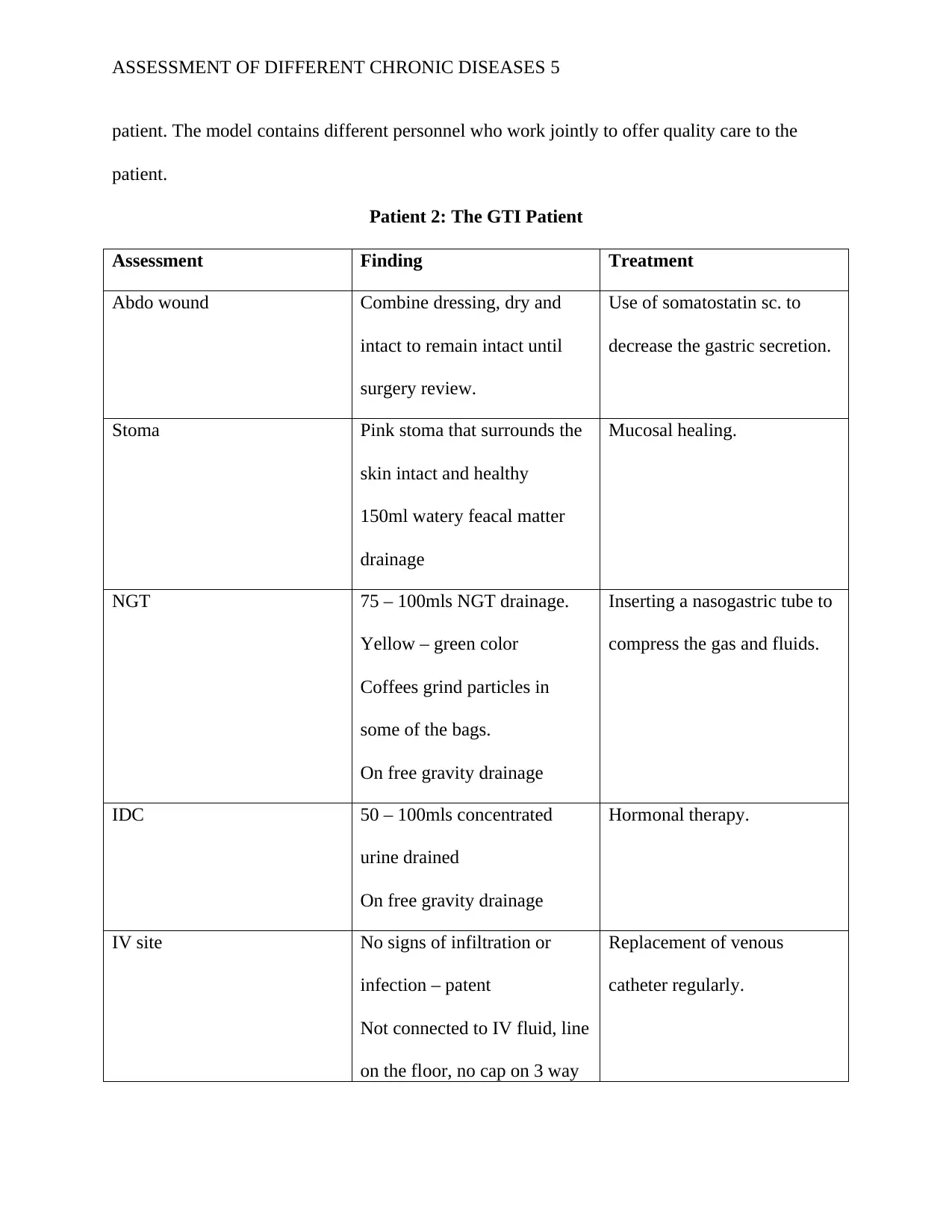
ASSESSMENT OF DIFFERENT CHRONIC DISEASES 5
patient. The model contains different personnel who work jointly to offer quality care to the
patient.
Patient 2: The GTI Patient
Assessment Finding Treatment
Abdo wound Combine dressing, dry and
intact to remain intact until
surgery review.
Use of somatostatin sc. to
decrease the gastric secretion.
Stoma Pink stoma that surrounds the
skin intact and healthy
150ml watery feacal matter
drainage
Mucosal healing.
NGT 75 – 100mls NGT drainage.
Yellow – green color
Coffees grind particles in
some of the bags.
On free gravity drainage
Inserting a nasogastric tube to
compress the gas and fluids.
IDC 50 – 100mls concentrated
urine drained
On free gravity drainage
Hormonal therapy.
IV site No signs of infiltration or
infection – patent
Not connected to IV fluid, line
on the floor, no cap on 3 way
Replacement of venous
catheter regularly.
patient. The model contains different personnel who work jointly to offer quality care to the
patient.
Patient 2: The GTI Patient
Assessment Finding Treatment
Abdo wound Combine dressing, dry and
intact to remain intact until
surgery review.
Use of somatostatin sc. to
decrease the gastric secretion.
Stoma Pink stoma that surrounds the
skin intact and healthy
150ml watery feacal matter
drainage
Mucosal healing.
NGT 75 – 100mls NGT drainage.
Yellow – green color
Coffees grind particles in
some of the bags.
On free gravity drainage
Inserting a nasogastric tube to
compress the gas and fluids.
IDC 50 – 100mls concentrated
urine drained
On free gravity drainage
Hormonal therapy.
IV site No signs of infiltration or
infection – patent
Not connected to IV fluid, line
on the floor, no cap on 3 way
Replacement of venous
catheter regularly.
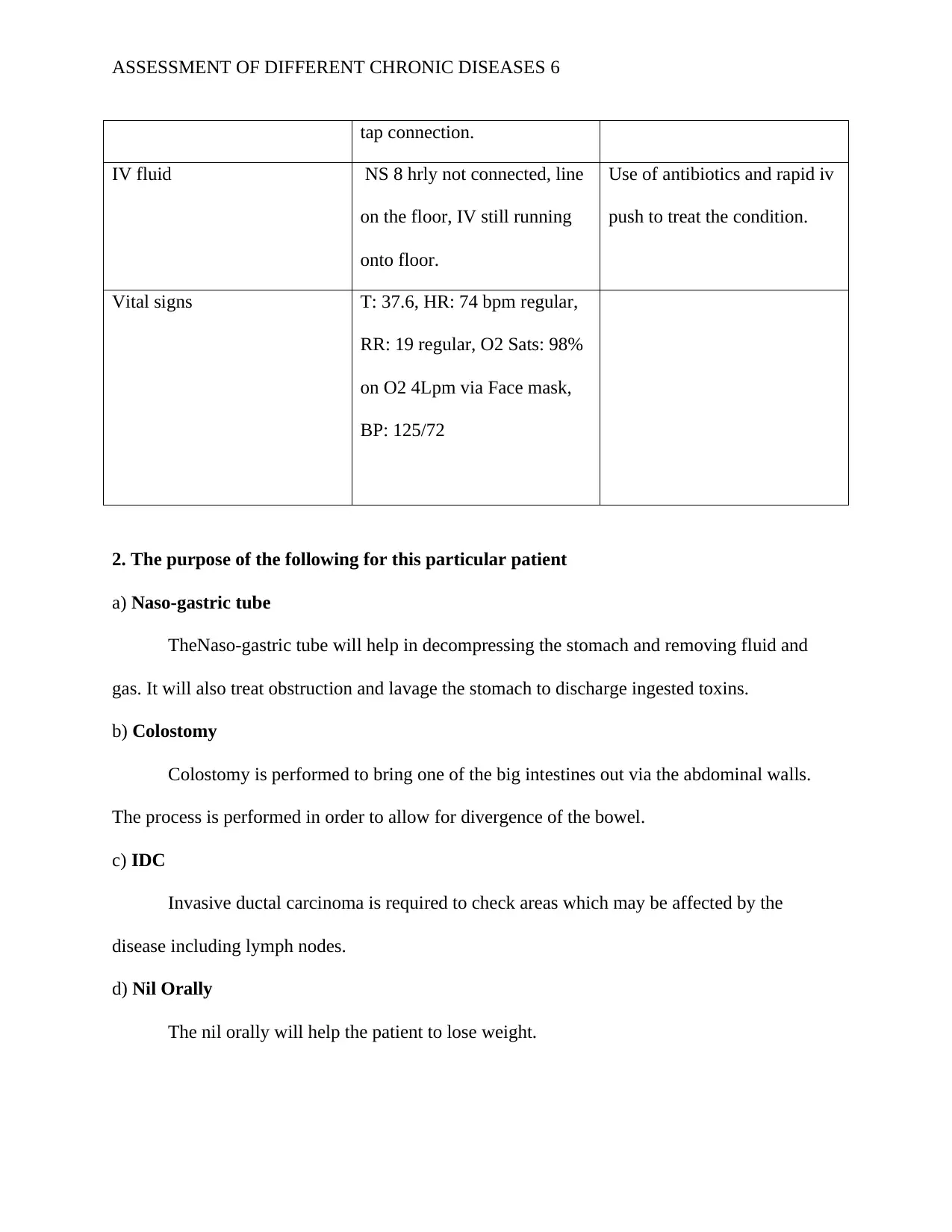
ASSESSMENT OF DIFFERENT CHRONIC DISEASES 6
tap connection.
IV fluid NS 8 hrly not connected, line
on the floor, IV still running
onto floor.
Use of antibiotics and rapid iv
push to treat the condition.
Vital signs T: 37.6, HR: 74 bpm regular,
RR: 19 regular, O2 Sats: 98%
on O2 4Lpm via Face mask,
BP: 125/72
2. The purpose of the following for this particular patient
a) Naso-gastric tube
TheNaso-gastric tube will help in decompressing the stomach and removing fluid and
gas. It will also treat obstruction and lavage the stomach to discharge ingested toxins.
b) Colostomy
Colostomy is performed to bring one of the big intestines out via the abdominal walls.
The process is performed in order to allow for divergence of the bowel.
c) IDC
Invasive ductal carcinoma is required to check areas which may be affected by the
disease including lymph nodes.
d) Nil Orally
The nil orally will help the patient to lose weight.
tap connection.
IV fluid NS 8 hrly not connected, line
on the floor, IV still running
onto floor.
Use of antibiotics and rapid iv
push to treat the condition.
Vital signs T: 37.6, HR: 74 bpm regular,
RR: 19 regular, O2 Sats: 98%
on O2 4Lpm via Face mask,
BP: 125/72
2. The purpose of the following for this particular patient
a) Naso-gastric tube
TheNaso-gastric tube will help in decompressing the stomach and removing fluid and
gas. It will also treat obstruction and lavage the stomach to discharge ingested toxins.
b) Colostomy
Colostomy is performed to bring one of the big intestines out via the abdominal walls.
The process is performed in order to allow for divergence of the bowel.
c) IDC
Invasive ductal carcinoma is required to check areas which may be affected by the
disease including lymph nodes.
d) Nil Orally
The nil orally will help the patient to lose weight.
⊘ This is a preview!⊘
Do you want full access?
Subscribe today to unlock all pages.

Trusted by 1+ million students worldwide
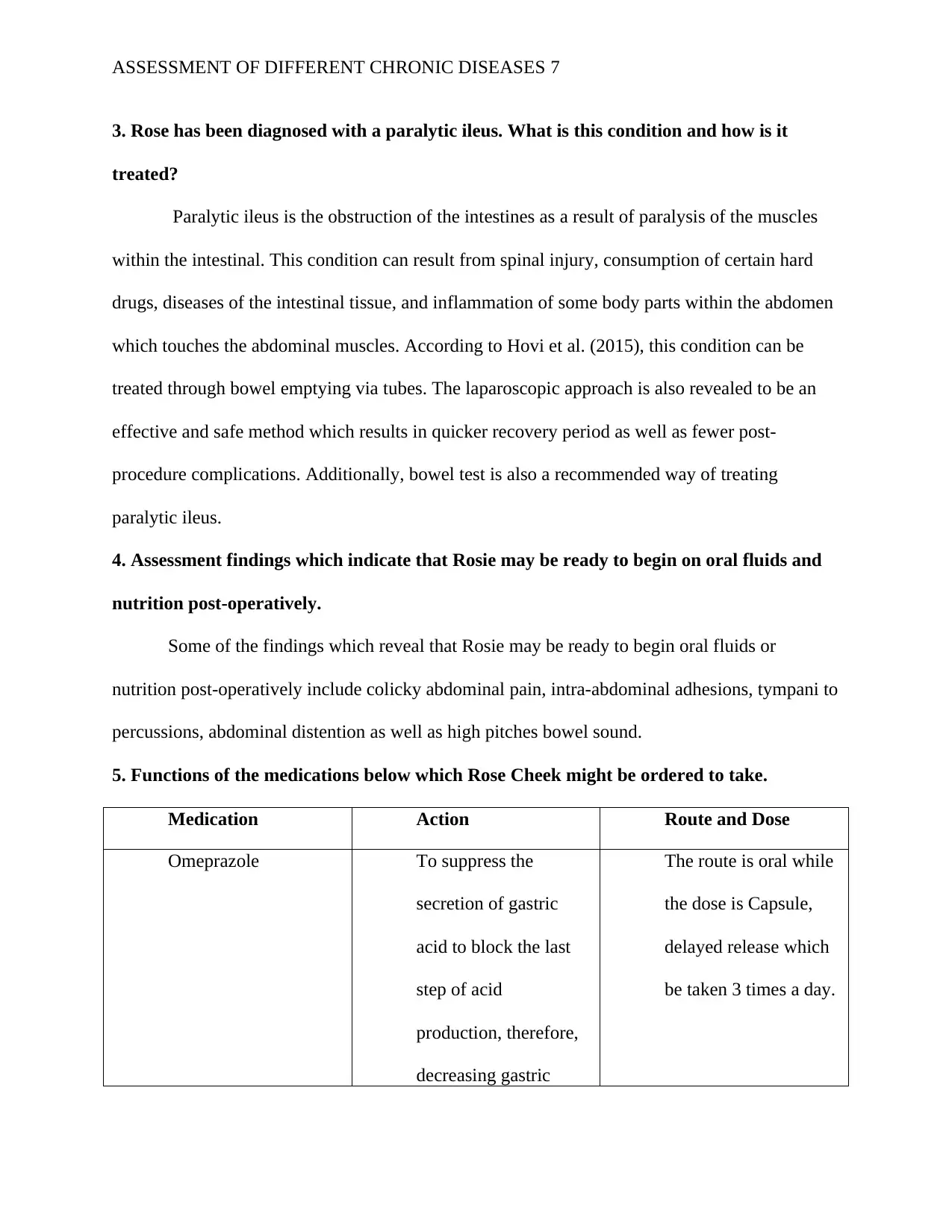
ASSESSMENT OF DIFFERENT CHRONIC DISEASES 7
3. Rose has been diagnosed with a paralytic ileus. What is this condition and how is it
treated?
Paralytic ileus is the obstruction of the intestines as a result of paralysis of the muscles
within the intestinal. This condition can result from spinal injury, consumption of certain hard
drugs, diseases of the intestinal tissue, and inflammation of some body parts within the abdomen
which touches the abdominal muscles. According to Hovi et al. (2015), this condition can be
treated through bowel emptying via tubes. The laparoscopic approach is also revealed to be an
effective and safe method which results in quicker recovery period as well as fewer post-
procedure complications. Additionally, bowel test is also a recommended way of treating
paralytic ileus.
4. Assessment findings which indicate that Rosie may be ready to begin on oral fluids and
nutrition post-operatively.
Some of the findings which reveal that Rosie may be ready to begin oral fluids or
nutrition post-operatively include colicky abdominal pain, intra-abdominal adhesions, tympani to
percussions, abdominal distention as well as high pitches bowel sound.
5. Functions of the medications below which Rose Cheek might be ordered to take.
Medication Action Route and Dose
Omeprazole To suppress the
secretion of gastric
acid to block the last
step of acid
production, therefore,
decreasing gastric
The route is oral while
the dose is Capsule,
delayed release which
be taken 3 times a day.
3. Rose has been diagnosed with a paralytic ileus. What is this condition and how is it
treated?
Paralytic ileus is the obstruction of the intestines as a result of paralysis of the muscles
within the intestinal. This condition can result from spinal injury, consumption of certain hard
drugs, diseases of the intestinal tissue, and inflammation of some body parts within the abdomen
which touches the abdominal muscles. According to Hovi et al. (2015), this condition can be
treated through bowel emptying via tubes. The laparoscopic approach is also revealed to be an
effective and safe method which results in quicker recovery period as well as fewer post-
procedure complications. Additionally, bowel test is also a recommended way of treating
paralytic ileus.
4. Assessment findings which indicate that Rosie may be ready to begin on oral fluids and
nutrition post-operatively.
Some of the findings which reveal that Rosie may be ready to begin oral fluids or
nutrition post-operatively include colicky abdominal pain, intra-abdominal adhesions, tympani to
percussions, abdominal distention as well as high pitches bowel sound.
5. Functions of the medications below which Rose Cheek might be ordered to take.
Medication Action Route and Dose
Omeprazole To suppress the
secretion of gastric
acid to block the last
step of acid
production, therefore,
decreasing gastric
The route is oral while
the dose is Capsule,
delayed release which
be taken 3 times a day.
Paraphrase This Document
Need a fresh take? Get an instant paraphrase of this document with our AI Paraphraser

ASSESSMENT OF DIFFERENT CHRONIC DISEASES 8
acidity.
Ondansetron To help in regulating
bowel movements.
The route is injection
whereas the dosage i 4
mg/5 mL ; 32 mg/50
mL-D5% ; 2 mg/mL ;
4 mg ; 8 mg ; 24 mg ;
32 mg/50 mL-NaCl
0.9% s
Krytil To block the cations
of various chemicals in
the body which may
trigger vomiting or
nausea.
The route is oral while
the dosage is oral
tablet containing 2.25
mg of granisetron
hydrochlorides and
should be taken twice a
day.
Buscopan To relieve colicky
abdominal pain and
block the muscarinic
receptors which are
found within the
smooth muscles of the
gastrointestinal tract.
The route is oral while
the dosage is 20mg
three times a day
acidity.
Ondansetron To help in regulating
bowel movements.
The route is injection
whereas the dosage i 4
mg/5 mL ; 32 mg/50
mL-D5% ; 2 mg/mL ;
4 mg ; 8 mg ; 24 mg ;
32 mg/50 mL-NaCl
0.9% s
Krytil To block the cations
of various chemicals in
the body which may
trigger vomiting or
nausea.
The route is oral while
the dosage is oral
tablet containing 2.25
mg of granisetron
hydrochlorides and
should be taken twice a
day.
Buscopan To relieve colicky
abdominal pain and
block the muscarinic
receptors which are
found within the
smooth muscles of the
gastrointestinal tract.
The route is oral while
the dosage is 20mg
three times a day
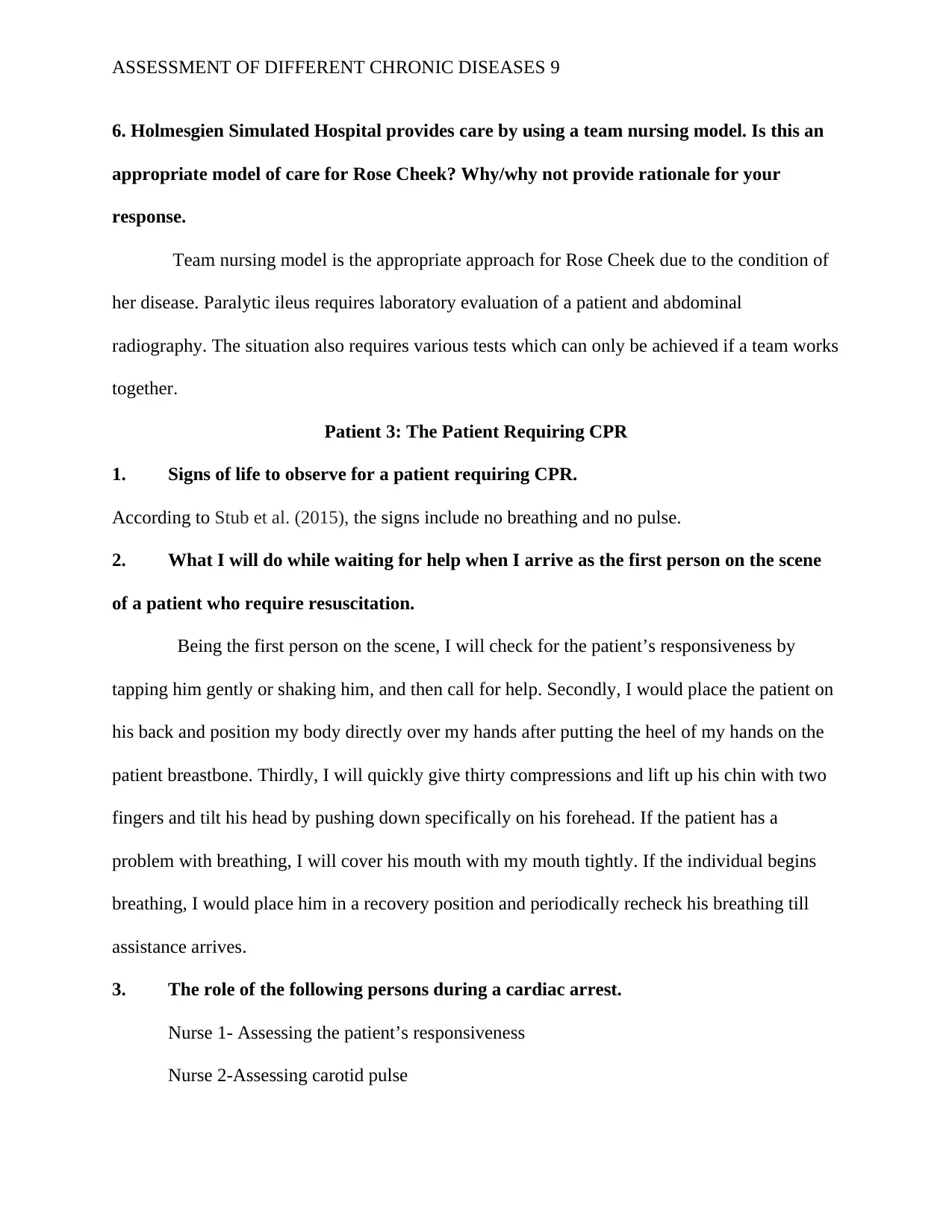
ASSESSMENT OF DIFFERENT CHRONIC DISEASES 9
6. Holmesgien Simulated Hospital provides care by using a team nursing model. Is this an
appropriate model of care for Rose Cheek? Why/why not provide rationale for your
response.
Team nursing model is the appropriate approach for Rose Cheek due to the condition of
her disease. Paralytic ileus requires laboratory evaluation of a patient and abdominal
radiography. The situation also requires various tests which can only be achieved if a team works
together.
Patient 3: The Patient Requiring CPR
1. Signs of life to observe for a patient requiring CPR.
According to Stub et al. (2015), the signs include no breathing and no pulse.
2. What I will do while waiting for help when I arrive as the first person on the scene
of a patient who require resuscitation.
Being the first person on the scene, I will check for the patient’s responsiveness by
tapping him gently or shaking him, and then call for help. Secondly, I would place the patient on
his back and position my body directly over my hands after putting the heel of my hands on the
patient breastbone. Thirdly, I will quickly give thirty compressions and lift up his chin with two
fingers and tilt his head by pushing down specifically on his forehead. If the patient has a
problem with breathing, I will cover his mouth with my mouth tightly. If the individual begins
breathing, I would place him in a recovery position and periodically recheck his breathing till
assistance arrives.
3. The role of the following persons during a cardiac arrest.
Nurse 1- Assessing the patient’s responsiveness
Nurse 2-Assessing carotid pulse
6. Holmesgien Simulated Hospital provides care by using a team nursing model. Is this an
appropriate model of care for Rose Cheek? Why/why not provide rationale for your
response.
Team nursing model is the appropriate approach for Rose Cheek due to the condition of
her disease. Paralytic ileus requires laboratory evaluation of a patient and abdominal
radiography. The situation also requires various tests which can only be achieved if a team works
together.
Patient 3: The Patient Requiring CPR
1. Signs of life to observe for a patient requiring CPR.
According to Stub et al. (2015), the signs include no breathing and no pulse.
2. What I will do while waiting for help when I arrive as the first person on the scene
of a patient who require resuscitation.
Being the first person on the scene, I will check for the patient’s responsiveness by
tapping him gently or shaking him, and then call for help. Secondly, I would place the patient on
his back and position my body directly over my hands after putting the heel of my hands on the
patient breastbone. Thirdly, I will quickly give thirty compressions and lift up his chin with two
fingers and tilt his head by pushing down specifically on his forehead. If the patient has a
problem with breathing, I will cover his mouth with my mouth tightly. If the individual begins
breathing, I would place him in a recovery position and periodically recheck his breathing till
assistance arrives.
3. The role of the following persons during a cardiac arrest.
Nurse 1- Assessing the patient’s responsiveness
Nurse 2-Assessing carotid pulse
⊘ This is a preview!⊘
Do you want full access?
Subscribe today to unlock all pages.

Trusted by 1+ million students worldwide
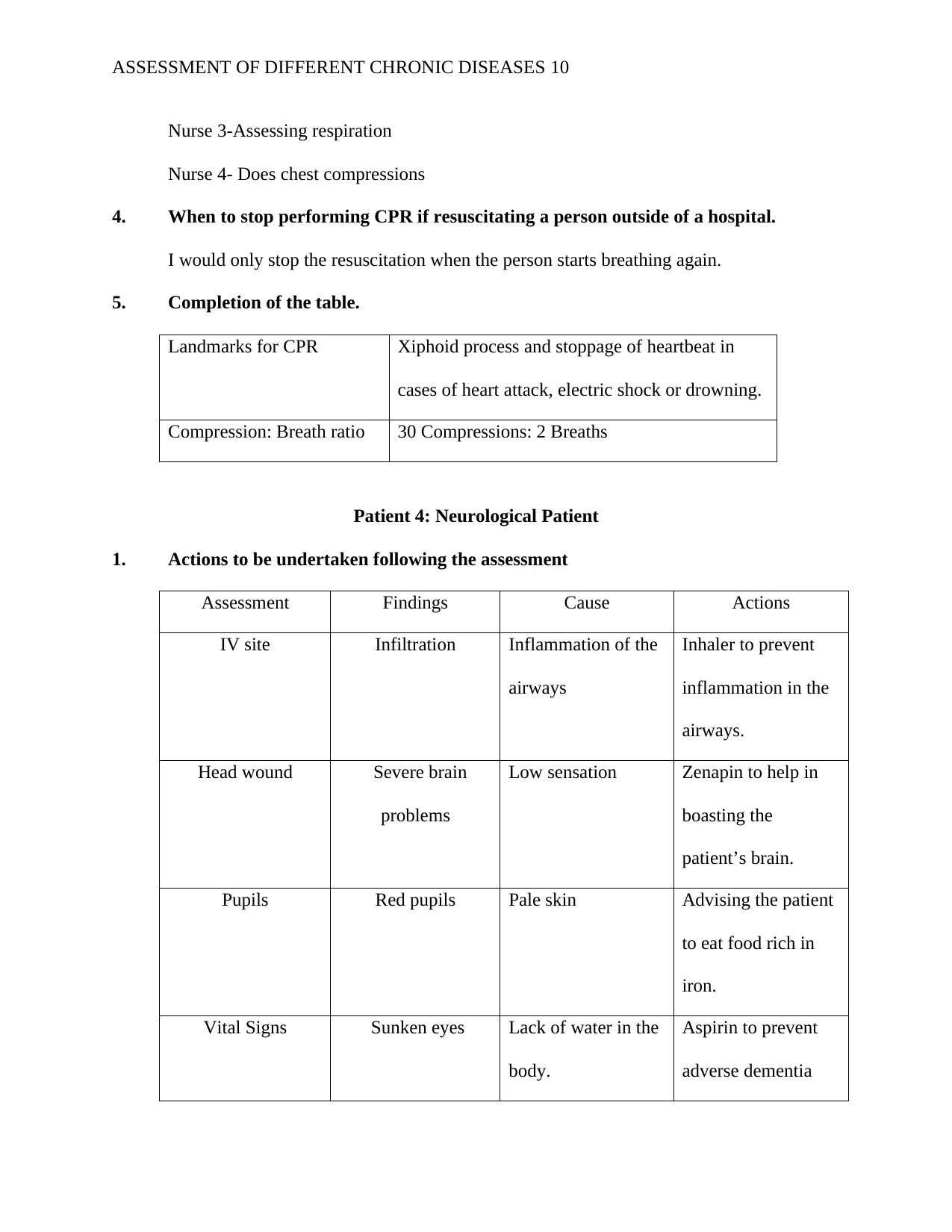
ASSESSMENT OF DIFFERENT CHRONIC DISEASES 10
Nurse 3-Assessing respiration
Nurse 4- Does chest compressions
4. When to stop performing CPR if resuscitating a person outside of a hospital.
I would only stop the resuscitation when the person starts breathing again.
5. Completion of the table.
Landmarks for CPR Xiphoid process and stoppage of heartbeat in
cases of heart attack, electric shock or drowning.
Compression: Breath ratio 30 Compressions: 2 Breaths
Patient 4: Neurological Patient
1. Actions to be undertaken following the assessment
Assessment Findings Cause Actions
IV site Infiltration Inflammation of the
airways
Inhaler to prevent
inflammation in the
airways.
Head wound Severe brain
problems
Low sensation Zenapin to help in
boasting the
patient’s brain.
Pupils Red pupils Pale skin Advising the patient
to eat food rich in
iron.
Vital Signs Sunken eyes Lack of water in the
body.
Aspirin to prevent
adverse dementia
Nurse 3-Assessing respiration
Nurse 4- Does chest compressions
4. When to stop performing CPR if resuscitating a person outside of a hospital.
I would only stop the resuscitation when the person starts breathing again.
5. Completion of the table.
Landmarks for CPR Xiphoid process and stoppage of heartbeat in
cases of heart attack, electric shock or drowning.
Compression: Breath ratio 30 Compressions: 2 Breaths
Patient 4: Neurological Patient
1. Actions to be undertaken following the assessment
Assessment Findings Cause Actions
IV site Infiltration Inflammation of the
airways
Inhaler to prevent
inflammation in the
airways.
Head wound Severe brain
problems
Low sensation Zenapin to help in
boasting the
patient’s brain.
Pupils Red pupils Pale skin Advising the patient
to eat food rich in
iron.
Vital Signs Sunken eyes Lack of water in the
body.
Aspirin to prevent
adverse dementia
Paraphrase This Document
Need a fresh take? Get an instant paraphrase of this document with our AI Paraphraser
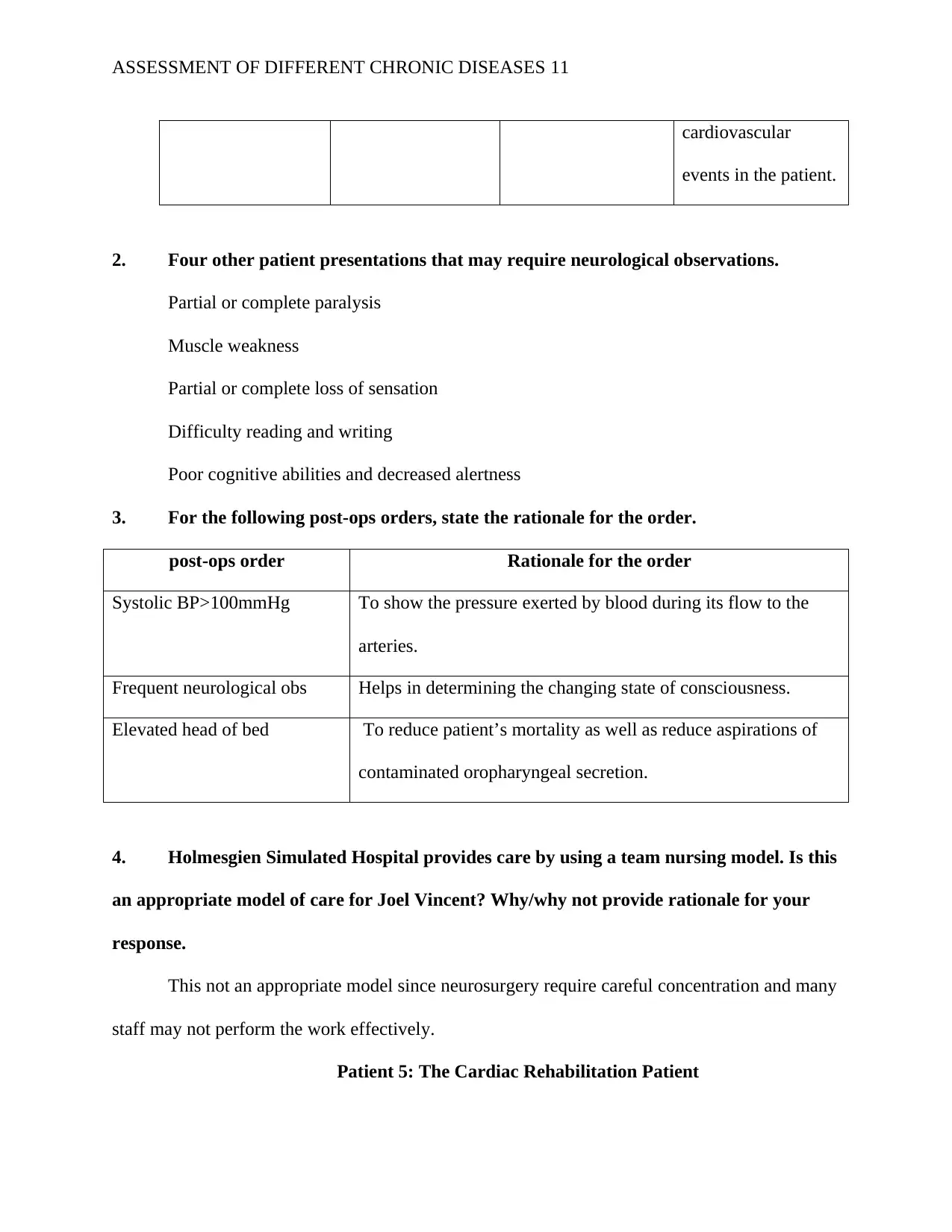
ASSESSMENT OF DIFFERENT CHRONIC DISEASES 11
cardiovascular
events in the patient.
2. Four other patient presentations that may require neurological observations.
Partial or complete paralysis
Muscle weakness
Partial or complete loss of sensation
Difficulty reading and writing
Poor cognitive abilities and decreased alertness
3. For the following post-ops orders, state the rationale for the order.
post-ops order Rationale for the order
Systolic BP>100mmHg To show the pressure exerted by blood during its flow to the
arteries.
Frequent neurological obs Helps in determining the changing state of consciousness.
Elevated head of bed To reduce patient’s mortality as well as reduce aspirations of
contaminated oropharyngeal secretion.
4. Holmesgien Simulated Hospital provides care by using a team nursing model. Is this
an appropriate model of care for Joel Vincent? Why/why not provide rationale for your
response.
This not an appropriate model since neurosurgery require careful concentration and many
staff may not perform the work effectively.
Patient 5: The Cardiac Rehabilitation Patient
cardiovascular
events in the patient.
2. Four other patient presentations that may require neurological observations.
Partial or complete paralysis
Muscle weakness
Partial or complete loss of sensation
Difficulty reading and writing
Poor cognitive abilities and decreased alertness
3. For the following post-ops orders, state the rationale for the order.
post-ops order Rationale for the order
Systolic BP>100mmHg To show the pressure exerted by blood during its flow to the
arteries.
Frequent neurological obs Helps in determining the changing state of consciousness.
Elevated head of bed To reduce patient’s mortality as well as reduce aspirations of
contaminated oropharyngeal secretion.
4. Holmesgien Simulated Hospital provides care by using a team nursing model. Is this
an appropriate model of care for Joel Vincent? Why/why not provide rationale for your
response.
This not an appropriate model since neurosurgery require careful concentration and many
staff may not perform the work effectively.
Patient 5: The Cardiac Rehabilitation Patient
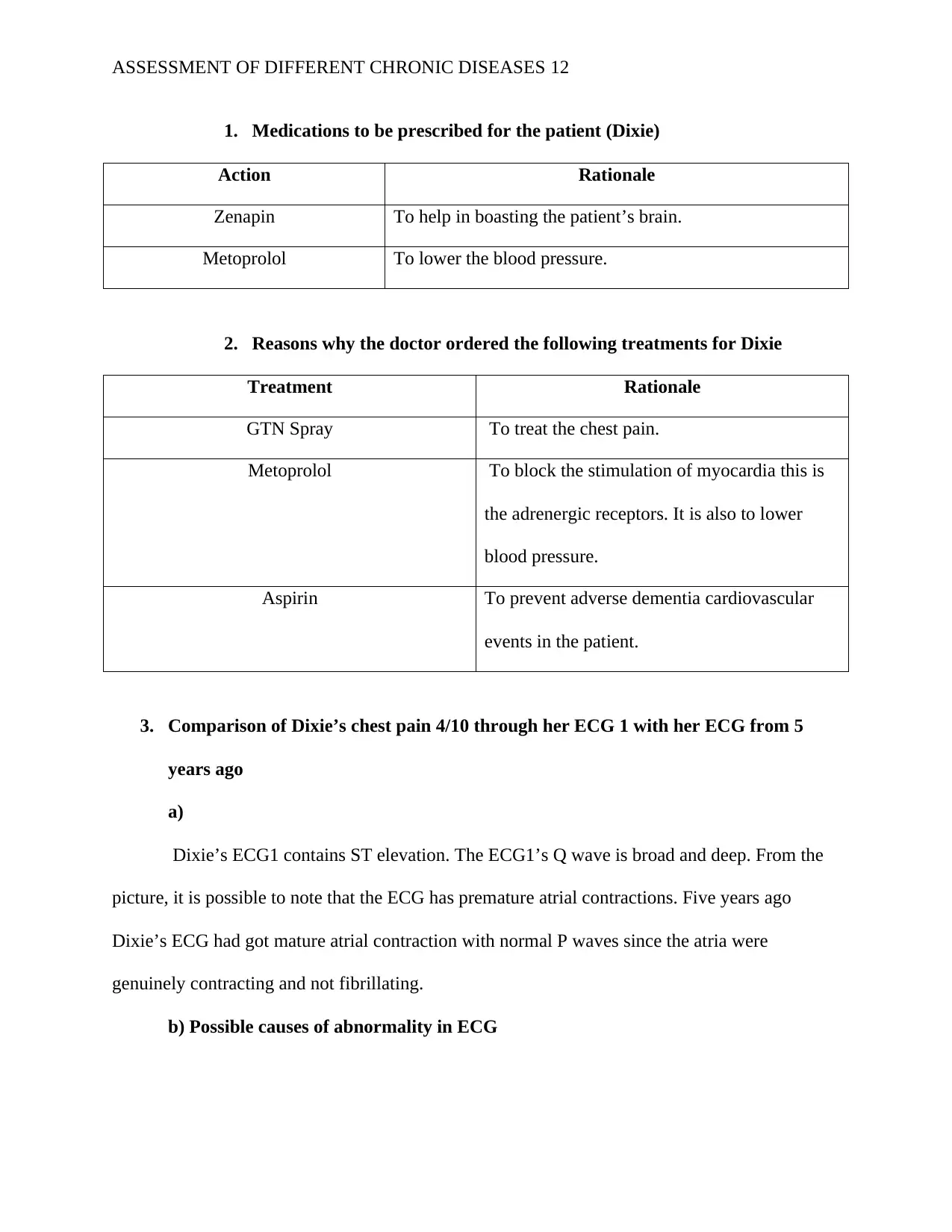
ASSESSMENT OF DIFFERENT CHRONIC DISEASES 12
1. Medications to be prescribed for the patient (Dixie)
Action Rationale
Zenapin To help in boasting the patient’s brain.
Metoprolol To lower the blood pressure.
2. Reasons why the doctor ordered the following treatments for Dixie
Treatment Rationale
GTN Spray To treat the chest pain.
Metoprolol To block the stimulation of myocardia this is
the adrenergic receptors. It is also to lower
blood pressure.
Aspirin To prevent adverse dementia cardiovascular
events in the patient.
3. Comparison of Dixie’s chest pain 4/10 through her ECG 1 with her ECG from 5
years ago
a)
Dixie’s ECG1 contains ST elevation. The ECG1’s Q wave is broad and deep. From the
picture, it is possible to note that the ECG has premature atrial contractions. Five years ago
Dixie’s ECG had got mature atrial contraction with normal P waves since the atria were
genuinely contracting and not fibrillating.
b) Possible causes of abnormality in ECG
1. Medications to be prescribed for the patient (Dixie)
Action Rationale
Zenapin To help in boasting the patient’s brain.
Metoprolol To lower the blood pressure.
2. Reasons why the doctor ordered the following treatments for Dixie
Treatment Rationale
GTN Spray To treat the chest pain.
Metoprolol To block the stimulation of myocardia this is
the adrenergic receptors. It is also to lower
blood pressure.
Aspirin To prevent adverse dementia cardiovascular
events in the patient.
3. Comparison of Dixie’s chest pain 4/10 through her ECG 1 with her ECG from 5
years ago
a)
Dixie’s ECG1 contains ST elevation. The ECG1’s Q wave is broad and deep. From the
picture, it is possible to note that the ECG has premature atrial contractions. Five years ago
Dixie’s ECG had got mature atrial contraction with normal P waves since the atria were
genuinely contracting and not fibrillating.
b) Possible causes of abnormality in ECG
⊘ This is a preview!⊘
Do you want full access?
Subscribe today to unlock all pages.

Trusted by 1+ million students worldwide
1 out of 14
Related Documents
Your All-in-One AI-Powered Toolkit for Academic Success.
+13062052269
info@desklib.com
Available 24*7 on WhatsApp / Email
![[object Object]](/_next/static/media/star-bottom.7253800d.svg)
Unlock your academic potential
Copyright © 2020–2025 A2Z Services. All Rights Reserved. Developed and managed by ZUCOL.





